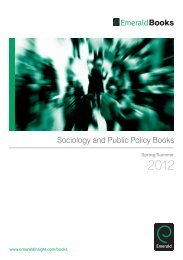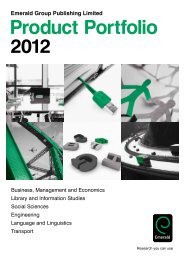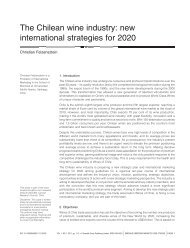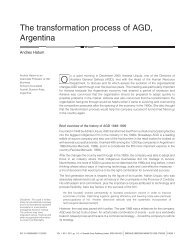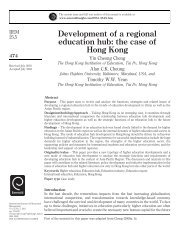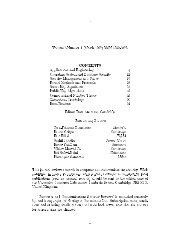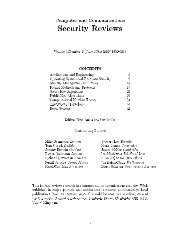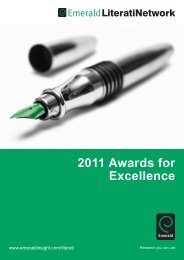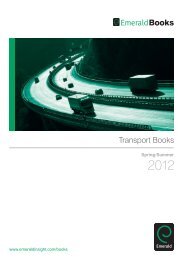Facilitating transdisciplinary sustainable development research ...
Facilitating transdisciplinary sustainable development research ...
Facilitating transdisciplinary sustainable development research ...
Create successful ePaper yourself
Turn your PDF publications into a flip-book with our unique Google optimized e-Paper software.
IJSHE<br />
11,1<br />
42<br />
the e-panel by the moderator, both during and after the conversation. The majority of<br />
audience members seemed content just to “listen in” to the e-panel dialogue. On two<br />
occasions the audience was more animated – developing discussions amongst<br />
themselves, not necessarily directly connected with the panel; but these still only<br />
involved two or three audience members.<br />
Direct feedback e-mailed to the <strong>research</strong> team during the discussion suggested that<br />
some audience members were disappointed not to be able to comment directly to the<br />
e-panel, and there was also no attempt to moderate audience discussion during or<br />
following the two-hour e-panel conversation. Anecdotally, we have observed that there<br />
may be a relationship between the quality of content and speed of dialogue with whether<br />
or not the audience chooses to dialogue among themselves while simultaneously<br />
listening to the e-panel audience dialogues. In other words, when the expert panel<br />
dialogue is lurching or conflict-ridden, the audience tends to be more interactive. As well,<br />
there appears to be an age variable with younger people being able to multi-task more<br />
easily, especially electronically, simultaneously dialoguing among themselves and<br />
listening to the expert discussion. Survey data from panellists, however, did not suggest<br />
that contributors themselves feel held back along age or technical grounds.<br />
The analysis of the capacity of e-dialogues to achieve the desired <strong>research</strong> outcomes<br />
was conducted using triangulation through a multiple methods approach. Members of<br />
the <strong>research</strong> team observed the dialogue as it took place, and then immediately<br />
following each dialogue an online survey was administered to the participants.<br />
Discussion of results<br />
The participants in the three <strong>research</strong> outcomes of the e-dialogues rated the process as<br />
very effective; there was little repetition of earlier critiques of the tool in its inception,<br />
2000-2005. Overall, the majority of participants felt that the medium was conducive to<br />
the <strong>research</strong> goals and outcomes as planned. In the first <strong>research</strong> outcome, the critique<br />
of a peer-reviewed draft journal article, the co-authors felt that the <strong>transdisciplinary</strong><br />
critique did not significantly strengthen the quality of the draft paper. Although the<br />
experts rated their experience as qualitatively significant and meaningful, an emergent<br />
finding was that there was significant disagreement among the experts on the central<br />
premise of the paper which the authors took as a given; that is, that gentrification has<br />
some unanticipated inequitable outcomes. There was clearly a values difference among<br />
the <strong>transdisciplinary</strong> team and the co-authors, underscoring the highly normative<br />
nature of <strong>sustainable</strong> <strong>development</strong> discourse. The other observation by the authors<br />
was that the paper was submitted in very draft form, and the critique did reveal that<br />
they were unclear in their central premise and consequently that was sharpened as<br />
a result of the <strong>transdisciplinary</strong> feedback. It may well be that academic publication<br />
demands only interdisciplinary rather than <strong>transdisciplinary</strong> critique, especially when<br />
the target audience is peer-reviewed academic journals.<br />
The gender differences in conversation styles observed by Barrett and Lally (1999)<br />
were also observed here. The <strong>research</strong> confirmed that men send more and longer<br />
messages, but women send messages that are more interactive and refer to past<br />
messages, although further dialogues are needed to provide more text samples to<br />
further test the post length and content – Figure 1 shows the frequency of posting,<br />
highlighting the male and female panellists, for one of the dialogues. This gender<br />
difference did not seem to hinder dialogue, which also agrees with the earlier study.



